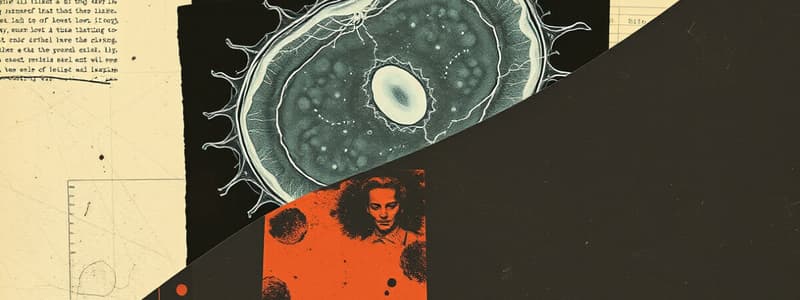Podcast
Questions and Answers
Prokaryotic cells are more complex than eukaryotic cells.
Prokaryotic cells are more complex than eukaryotic cells.
False (B)
Mitosis results in the production of four genetically diverse daughter cells.
Mitosis results in the production of four genetically diverse daughter cells.
False (B)
Photosynthesis occurs in the mitochondria of plant cells.
Photosynthesis occurs in the mitochondria of plant cells.
False (B)
Genotype refers to the observable traits of an organism.
Genotype refers to the observable traits of an organism.
Humans have 46 chromosomes that consist of DNA and contain genes.
Humans have 46 chromosomes that consist of DNA and contain genes.
Alleles are identical forms of a gene.
Alleles are identical forms of a gene.
CRISPR technology is a form of genetic engineering.
CRISPR technology is a form of genetic engineering.
Mutations can only be harmful and do not provide benefits to organisms.
Mutations can only be harmful and do not provide benefits to organisms.
Flashcards are hidden until you start studying
Study Notes
Cell Biology
- Basic Unit of Life: Cells are the fundamental units of structure and function in living organisms.
- Types of Cells:
- Prokaryotic: Simple, lack membrane-bound organelles (e.g., bacteria).
- Eukaryotic: Complex, contain membrane-bound organelles (e.g., plant and animal cells).
- Cell Structure:
- Nucleus: Contains genetic material (DNA).
- Cell Membrane: Semi-permeable barrier that regulates entry and exit of substances.
- Cytoplasm: Jelly-like substance where cellular processes occur.
- Organelles: Specialized structures within the cell (e.g., mitochondria, endoplasmic reticulum, Golgi apparatus).
- Cell Division:
- Mitosis: Process of cell division resulting in two identical daughter cells; essential for growth and repair.
- Meiosis: Specialized cell division producing gametes (sperm and eggs), resulting in genetic diversity.
- Cell Metabolism:
- Respiration: Process of converting glucose into energy (ATP) in mitochondria.
- Photosynthesis: In plants, the process of converting light energy into chemical energy (glucose) in chloroplasts.
Genetics
- Basic Concepts:
- Gene: A segment of DNA that encodes a protein or trait.
- Allele: Different forms of a gene.
- Chromosome: Structures made of DNA that contain genes; humans have 46 (23 pairs).
- Inheritance Patterns:
- Mendelian Genetics: Study of inheritance patterns through dominant and recessive traits.
- Punnett Squares: Tool for predicting the genetic outcome of crosses.
- Genotype vs. Phenotype: Genotype is the genetic makeup, while phenotype is the expressed traits.
- Mutations:
- Changes in DNA sequence that can lead to changes in phenotype; can be beneficial, neutral, or harmful.
- Types of mutations include point mutations, insertions, deletions.
- Genetic Technologies:
- Genetic Engineering: Altering the genetic material of an organism (e.g., CRISPR technology).
- Cloning: Producing genetically identical copies of an organism or cell.
- Population Genetics: Study of genetic variation within populations and how it changes over time (e.g., through natural selection, genetic drift).
Cell Biology
-
Cells are the fundamental structural and functional units of all living organisms.
-
Prokaryotic Cells: Simple organisms without membrane-bound organelles; examples include bacteria.
-
Eukaryotic Cells: More complex, containing membrane-bound organelles; examples include plant and animal cells.
-
Nucleus: Houses genetic material (DNA) and controls cellular activities.
-
Cell Membrane: A semi-permeable barrier that regulates the movement of substances in and out of the cell.
-
Cytoplasm: A viscous, jelly-like fluid where metabolic processes and organelle functions occur.
-
Organelles: Specialized structures performing specific functions; key organelles include:
- Mitochondria: Energy production through ATP synthesis.
- Endoplasmic Reticulum (ER): Protein and lipid synthesis.
- Golgi Apparatus: Modifies, sorts, and packages proteins for secretion.
-
Mitosis: A type of cell division resulting in two genetically identical daughter cells; vital for growth, repair, and asexual reproduction.
-
Meiosis: Specialized cell division that produces gametes (sperm and eggs); introduces genetic diversity through recombination and independent assortment.
-
Cellular Respiration: The process by which cells convert glucose into usable energy (ATP) within mitochondria.
-
Photosynthesis: Conducted by plants in chloroplasts to transform light energy into chemical energy stored as glucose.
Genetics
-
Gene: A segment of DNA that contains the instructions to produce proteins, influencing traits.
-
Allele: Different variations or forms of a particular gene.
-
Chromosome: DNA structures containing genes; humans possess 46 chromosomes organized in 23 pairs.
-
Mendelian Genetics: Focuses on inheritance patterns based on dominant and recessive traits discovered by Gregor Mendel.
-
Punnett Squares: A graphical tool for calculating the probability of genetic cross outcomes.
-
Genotype vs. Phenotype: The genotype is the organism's genetic makeup, while the phenotype is the observable physical expression of those genes.
-
Mutations: Alterations in the DNA sequence that can affect phenotype; they can be beneficial, neutral, or harmful. Types include:
- Point Mutations: Injure a single nucleotide base.
- Insertions: Add extra bases into the DNA sequence.
- Deletions: Remove bases from the DNA sequence.
-
Genetic Technologies:
- Genetic Engineering: A method of modifying an organism's genetic material, prominently using techniques like CRISPR.
- Cloning: The process of creating genetically identical copies of cells or organisms.
- Population Genetics: Examines genetic variation within populations and its changes over time, driven by mechanisms such as natural selection and genetic drift.
Studying That Suits You
Use AI to generate personalized quizzes and flashcards to suit your learning preferences.




